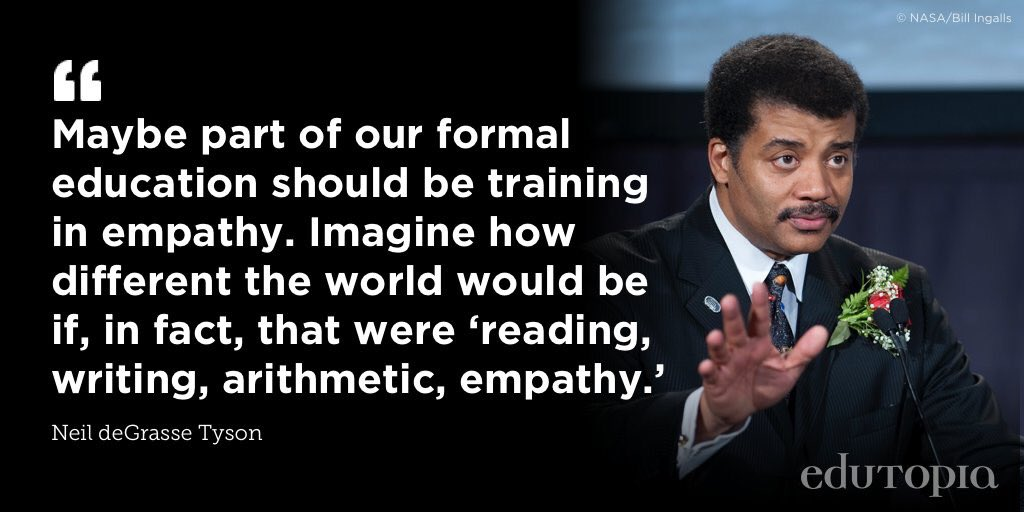Astrophysicist and science communicator Neil deGrasse Tyson once said that “humans aren’t as good as we should be in our capacity to empathize with the feelings and thoughts of others.”
Scanning back over the headlines of the past year, I can’t help but agree with his assessment. Recent events remind us all too clearly that, as a society, we’re still not that good at finding common ground, understanding different perspectives, and looking out for the well-being of others.
But Tyson believes that we could do better. His suggestion?

The Case for Teaching Empathy
Does empathy belong in our curriculum? Should we really be teaching it in the same way we teach vocabulary decoding or sentence composition? (After all, there are no end-of-grade tests that assess a student’s growth in compassion.)
First, I would point out that we are already teaching students all sorts of values that are not strictly tied to our academic content: Work ethic. Time management. Responsibility. Education scholars call this the “hidden curriculum.” It’s all that stuff we are conveying without saying it, the messages that are woven into the fabric of our policies and procedures.
Students are inevitably going to pick up ideas and values through interactions at school. So why not get intentional about teaching empathy? To echo Tyson, what would the world look like if we were shaping people who were not just better at solving equations, but better at caring? Not just better at reading literature, but better at understanding how other people feel?
There’s a growing movement of schools that are doing exactly that.
- In Denmark, widely called “one of the happiest countries in the world,” weekly empathy-building sessions have been a required component of classroom practice since 1993.
- Here in the US, numerous state Departments of Education have developed their own “Social-Emotional Learning (SEL) Toolkits” aimed at helping schools implement practices that support students’ emotional and interpersonal competencies (see Indiana’s model for example).
- Teachers in my own school district regularly participate in Compassionate Schools training, which focuses on the importance of responding to students with empathy.
Empathy Helps Students Inside and Outside the classroom
The research on programs that focus on empathy is clear. In 2011, a meta-analysis of more than 200 studies found that students who participated in evidence-based SEL programs made academic achievement gains 11 percentile points higher than their peers who did not participate in such programs.
In other words, training in empathy seems to be linked to higher test scores.
Perhaps this is because caring classrooms are simply better places to learn. Incorporating empathy-building practices has been shown to support the development of a positive classroom community. It also strengthens teacher-student relationships, which in turn leads to increased student engagement and motivation.
Programs working with high school students at low-income schools in Chicago have found that direct training in social-emotional capacities can radically alter a student’s academic trajectory. For example, a student who had a 1.8 GPA in her freshman year worked her way to a 3.4 in her sophomore year after participating in an SEL-focused program. She eventually went on to graduate with a 4.1. This is, of course, just one case, but it is by no means an outlier (“Why We Should Teach Empathy to Improve Education (And Test Scores)).

Shaping Lessons AND Practice
There’s a question we might be asking at this point: do all these benefits come from direct instruction on empathy or from teachers treating students with empathy?
The answer is Yes. It’s both.
Helping students grow their empathy muscles starts with stretching our own. We invite students into developing a deeper understanding of others by modeling an empathic mindset in our daily interactions with the class. The way in which we respond to an off-topic question or an interruption matters. The way we approach a repeated disciplinary issue or an angry outburst can make a real difference. Former teacher Ernie Mendes illustrates that beautifully in this article, where he provides a behind-the-scenes look at an interaction with one of his students, sharing concrete strategies for “choosing empathy” and building relationships that other teachers can emulate.
Based on new understandings of how trauma affects the brain, it’s possible that for many students, experiencing empathy can have a life-changing impact. The CDC’s landmark ACE study found that children who have undergone Adverse Childhood Experiences – including abuse, poverty, or witnessing violence – are at significant risk for a whole host of negative health outcomes later in life. What’s more, research has shown that trauma actually reshapes the developing brain in ways that hinder learning and self-management (see Dr. Nadine Burke Harris’ TED Talk for a full explanation on this).
The good news here is that these same studies found that the negative effects of ACES can be mitigated by protective factors. One of the most powerful of these is “caring adults outside the family who serve as mentors / role models.” By practicing empathy and utilizing trauma-informed teaching strategies, teachers have the opportunity to counteract the negative effects of trauma, inviting students into healthier ways of connecting with others that will continue to have a healing impact over the course of their lives.

First Steps
As educators, we are tasked with shaping the minds and hearts of our students. The “Why” of empathy instruction is clear. The “How” can seem like a big leap. Later this month I’ll be sharing another article with details about how to create a classroom space that models and allows for empathy. As a starting point, you can begin your empathetic research by reading my colleague Susan’s article “Representation Matters: Why Students Need to See Themselves in Your Classroom.” Remember that empathy is built moment by moment, interaction by interaction. Shake a student’s hand, ask a sincere question, or provide space for students to be vulnerable. No matter how you plan to move forward, just taking the first step can make a major difference in the lives of your students.



